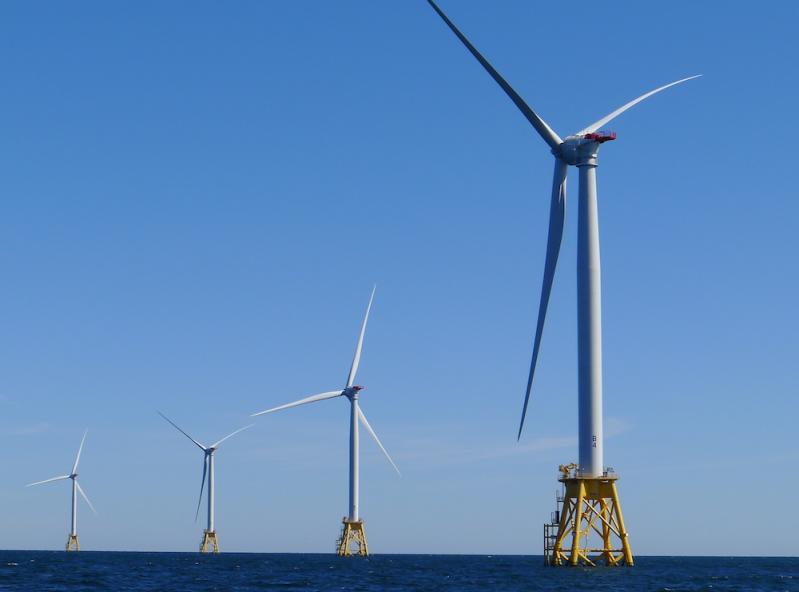After several years of discussion, debate, and public comment, the proposed South Fork Wind farm has come closer to reality. Both the East Hampton Town Board and the town trustees have voted to execute agreements with the developers allowing the wind farm's export cable to make landfall in the town and travel below ground, along town roads, to a Long Island Power Authority substation in East Hampton.
Over the objections of one member and after a contentious discussion, the town board voted on the agreement last Thursday. Separately, the trustees, who have jurisdiction over the Wainscott beach where the cable would come ashore, voted 9-to-0 on Monday to execute the "host community" agreement, a lease agreement, an agreement concerning dredging of Georgica Pond, and a revenue-sharing agreement with the town.
The wind farm developers propose to install up to 15 turbines in a federal lease area some 35 miles east of Montauk Point. The wind farm remains the subject of furious opposition, particularly in an effort to create an incorporated village of Wainscott. The export cable would make landfall there, at the end of Beach Lane.
Four of the town board's five members voted to authorize Supervisor Peter Van Scoyoc to execute the easement agreement with South Fork Wind, L.L.C., for the construction, installation, maintenance, repair, replacement, removal, and decommissioning of export cable and related facilities within town road rights of way that connect to the LIPA substation, off Cove Hollow Road. The resolution is subject to permissive referendum, meaning that if the opponents collect enough signatures on a petition, they could force a public vote on the project.
The town board also agreed 4 to 0 that the developers will make direct payments to the town totaling $29 million over the installation's 25-year lifetime. Under a revised agreement, the developers, Orsted U.S. Offshore Wind and Eversource Energy, will also make two payments of $2.75 million each, the first within 90 days of the start of the commercial operation, and the second within 30 days following the first anniversary of that date. Dubbed the "Wainscott Fund," that money is to be used for improvements and projects benefiting that hamlet.
The host-community agreement also includes two "milestone" payments of $500,000 each, one within 90 days of the agreement's effective date, the other within 90 days of the wind farm's beginning commercial operation. The annual payments will begin at $700,000, with 24 subsequent payments escalating by 2 percent per year. With an additional $100,000 license fee, the host-community agreement totals just over $29 million.
With the exception of the milestone payments, which will be evenly split between the town and trustees, the town will receive 60 percent of the host-community agreement money and the trustees the other 40 percent.
Councilman Jeff Bragman voted against the easement agreement and abstained from voting on the host community agreement, maintaining, as he has done all along, that the town would be better able to influence the project by waiting until state and federal reviews are complete. He has also said that many pertinent questions as to environmental review and the potential impact on the commercial fishing industry remain unanswered.
The board, Mr. Bragman said, should wait until the state Public Service Commission and the federal Bureau of Ocean Energy Management have completed their reviews. The public service commission, which must issue a Certificate of Environmental Compatibility and Public Need in order for the project to proceed, is expected to announce a decision by the end of March.
"I cannot join in voting for the resolution on the grounds I've stated previously," Mr. Bragman said, speaking of the easement agreement. "I think it's clear that waiting to execute the easement will not in any way delay or hamper the review." The time the board has taken to get to this point, he said, "has helped us better understand the project, and that will continue, but the appropriate time to vote and convey the easement is after the final decision" by the public service commission.
Councilwomen Kathee Burke-Gonzalez and Sylvia Overby read statements in support of the project, citing climate change as demanding quick action. "We need to de-carbonize our economies. And we need to do it as rapidly as possible, as we are a vulnerable coastal town," Ms. Burke-Gonzalez said. "I am more than satisfied with the exhaustive review that has taken place, as these agreements are comprehensive and highly detailed documents that have been adjusted, amended, and fine-tuned over the course of several years."
Councilman David Lys, who voted against supporting the project in 2018, said that his research since then, and information that has emerged in the P.S.C.'s deliberations, had resolved several of his questions. "The best thing we can continue to do is move forward," he said.
"We need to heal our planet, stop poisoning it with fossil fuels," said Mr. Van Scoyoc, while also citing increasing demand for electricity on the South Fork. The wind farm's developers say it will provide electricity sufficient to power 70,000 houses of average size. Potential adverse impacts and remediation have been addressed in the agreements, the supervisor said, and the P.S.C. deliberations are providing robust review of all town-related aspects.
Advocacy groups including Renewable Energy Long Island, the Sierra Club, Group for the East End, Citizens Campaign for the Environment, Concerned Citizens of Montauk, the Surfrider Foundation, and Defend H2O all favor the project, Mr. Van Scoyoc noted. The town and the trustees will continue to actively review its operations going forward, he said.
Mr. Bragman emphasized that he was both well aware of climate change and a believer in wind power, but that he had, for one thing, still-unanswered questions as to the wind farm's impact on Cox's Ledge, a "tremendously valuable ecosystem" that could have a serious impact on the town's commercial fishing industry if it were damaged.
During his lengthy comments, Ms. Burke-Gonzalez interrupted him, angrily accusing Mr. Bragman of "deliberately confusing people and mixing and matching" state and federal aspects of the project. "This project is for the landing of the cable," she said. "This easement is for the infrastructure to go from under the beach at Beach Lane to Cove Hollow. Because we can't meet our summer peak demand here."
"You cannot segment or put blinders on and say all we're doing is granting an easement," Mr. Bragman countered. "The easement is the effectuating mechanism for the project as a whole." Concerns about Cox's Ledge and the potential disruption of nearshore fish species' migratory patterns, which has also been raised by the wind farm's opponents, remain unresolved, he repeated. The easement "is not a small piece that can be looked at on its own."
"We know that anything that you do or build anywhere has some sort of impact" and must be carefully assessed, Mr. Van Scoyoc said. The town and trustees will continue to lobby for the protection of commercial fishing interests, he said, "but to somehow say that we should wait and try and leverage our approval for the landward portion, when . . . the community has let us know that they want this." He is aware of objections from Wainscott residents, he said, but the benefit of clean, renewable electricity outweighs the temporary inconvenience of off-season construction and the manhole covers the developers assert will be the sole lasting impact on Wainscott.
Comments received from the public, said Francis Bock, the trustees' clerk, before their vote on Monday, overwhelmingly favored execution of agreements with the developers.
Dan Spitzer, outside counsel to the trustees, told them that their efforts had greatly improved the project. He strongly criticized Citizens for the Preservation of Wainscott, which formed in opposition to the wind farm and spearheaded the drive for incorporation, for "deliberate efforts to misrepresent the record" in testimony to the public service commission. "You made the right choice" in finding Beach Lane the least consequential route to the LIPA substation, he told the trustees. And a lease agreement, as opposed to an easement, gives the trustees greater leverage, as it is easier to undo than an easement, he said.
The host-community agreement "does give us an opportunity to move forward with a lot of work," specifically dredging projects that will improve water quality, said Rick Drew, a trustee.
"We're proud of our collaboration with the town to reach easement agreements that not only advance the construction of South Fork Wind but also support the town's long-term environmental goals," Meaghan Wims, a spokeswoman for the developers, said last Thursday. "We look forward to continuing our partnership as we build this historic first offshore wind farm in New York."
Following the trustees' vote on Monday, she issued a similar statement. "The trustees have long been exemplary stewards and protectors of the environment, and they've demonstrated that commitment once again," she said.
Michael McKeon, a spokesman for Citizens for the Preservation of Wainscott, also issued a statement last Thursday. "This illegal and reckless action is the latest example of the town board's appeasement of Orsted to grab for dollars and indulge their ego," he said. "They are taking shortcuts because the supervisor is afraid of Wainscott incorporating. The struggle to protect Wainscott will continue."
In a letter to supporters, Gouri Edlich, the group's chairwoman, implied imminent legal action. "We believe we have significant grounds to sue the town for this illegal and reckless action," she wrote after the board's vote. "Our lawyers have been preparing for this moment for some time, and we expect to move forward with litigation in the coming days. We believe in its rush to appease Orsted, the town took shortcuts, and we are confident in our legal position."
Mr. Spitzer told the trustees that Judge Anthony Belsito, an administrative law judge, will issue a recommendation to the public service commission as to issuance of the Certificate of Environmental Compatibility and Public Need, which the commission may consider on March 18. That is unlikely to conclude the matter, however. Whatever the commission decides, he said, "will lead to litigation, challenging the validity of the agreements or the legality of any decision."
On the federal level, however, it is widely expected that under a new president, the government will have "a more positive view of offshore wind," he said.
This story has been updated to clarify Councilman Jeff Bragman's abstention from the town board's easement and host community agreement votes.




